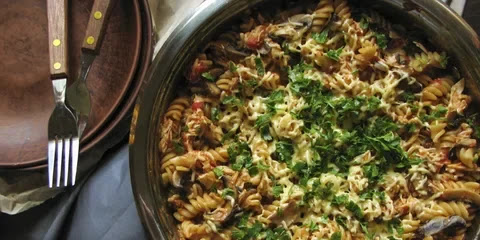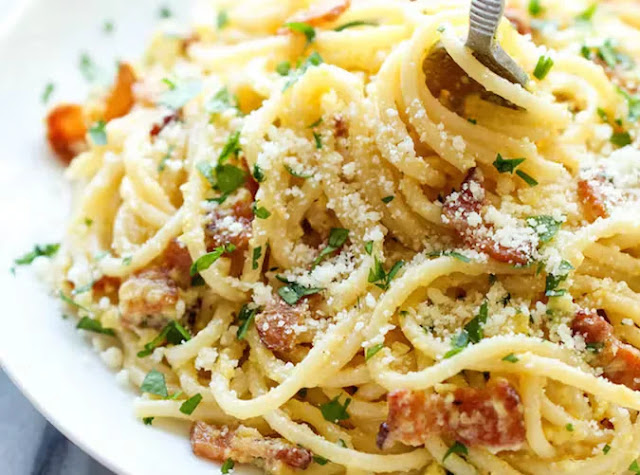In a world that often races against the clock, there's a delightful charm in dishes that embrace simplicity. Enter Lazy Pasta, a culinary masterpiece that thrives on the beauty of minimalism. This article celebrates the art of Lazy Pasta, exploring its origins, preparation, and the meditative joy of savoring uncomplicated flavors.
A Brief History
Lazy Pasta, also known as "Aglio e Olio," hails from the heart of Italian cuisine. Its roots can be traced to the impoverished regions of southern Italy, where peasants and laborers created magic from the humblest of ingredients. This dish was born out of necessity, where garlic, olive oil, and pasta were staples that kept stomachs full and souls satisfied.
The Ingredients
Lazy Pasta is a testament to the idea that less can indeed be more. Here's a rundown of the core components:
1. Pasta: Linguine, spaghetti, or any long, slender pasta variety works splendidly. The key is to choose high-quality pasta for a better result.
2. Garlic: The star of the show, garlic is sliced or minced, then gently sautéed in olive oil to infuse the dish with its robust flavor.
3. Olive Oil: Extra virgin olive oil provides the essential base for this dish, imparting its rich, fruity notes.
4. Red Pepper Flakes: A pinch of red pepper flakes adds a subtle kick, elevating the dish with a gentle heat.
5. Parsley: Fresh parsley, finely chopped, adds a burst of color and freshness as the finishing touch.
6. Parmesan Cheese: Grated Parmesan cheese, while optional, offers a creamy, savory layer.
The Preparation Process
1. Boil the Pasta: Cook the pasta in a large pot of salted boiling water until it reaches the desired level of doneness. Remember, Lazy Pasta shines when it's perfectly al dente.
2. Sauté the Garlic: While the pasta cooks, heat olive oil in a skillet over low heat. Add the sliced or minced garlic and a pinch of red pepper flakes. Sauté until the garlic turns golden and fragrant, taking care not to let it brown too much, as it can become bitter.
3. Combine Pasta and Garlic Oil: Drain the cooked pasta and transfer it directly to the skillet with the garlic oil. Toss the pasta to coat it evenly with the flavorful oil.
4. Finish with Parsley: Sprinkle finely chopped fresh parsley over the pasta, adding a vibrant touch of color and freshness.
5. Serve and Garnish: Plate the Lazy Pasta and offer grated Parmesan cheese at the table for those who desire a cheesy flourish. Some prefer a sprinkle of black pepper or extra red pepper flakes for added zing.
Tips and Variations:
Tips:
1. Use Quality Ingredients: Since Lazy Pasta relies on a few key ingredients, make sure they are of high quality. Opt for extra virgin olive oil, fresh garlic, and good-quality pasta for the best results.
2. Don't Rush the Garlic: Take your time when sautéing the garlic. It should be cooked over low heat until it becomes fragrant and golden but not browned, as overcooked garlic can turn bitter.
3. Season Generously: Don't forget to season the pasta water with salt before cooking. This is your chance to infuse flavor into the pasta itself.
4. Save Pasta Water: Before draining the cooked pasta, reserve a cup of the pasta water. It contains starch that can help create a silky sauce when combined with garlic oil.
5. Experiment with Chili Flakes: Adjust the amount of red pepper flakes to suit your spice tolerance. Some like it hot, while others prefer a milder dish.
6. Add Lemon Zest: For a refreshing twist, consider adding a bit of lemon zest to the garlic oil just before tossing the pasta. It adds a bright, citrusy note to the dish.
7. Fresh Herbs: While parsley is traditional, you can experiment with other fresh herbs like basil, oregano, or thyme for added complexity in flavor.
Variations:
1. Aglio e Olio with Anchovies: For a briny twist, add a few chopped anchovy fillets to the garlic oil. They will dissolve and infuse the dish with a rich umami flavor.
2. Aglio e Olio with Spinach: Toss in fresh spinach leaves at the end of cooking and allow them to wilt in the garlic oil. This adds a pop of color and an extra layer of nutrition.
3. Aglio e Olio with Sun-Dried Tomatoes: Add chopped sun-dried tomatoes to the garlic oil for a sweet and tangy contrast to the richness of the dish.
4. Aglio e Olio with Shrimp: Sauté shrimp in the garlic oil before adding the cooked pasta for a seafood twist. It's a delightful combination.
5. Aglio e Olio with Roasted Vegetables: Roast your favorite vegetables (such as cherry tomatoes, zucchini, or bell peppers) and toss them with the pasta for a heartier dish.
6. Aglio e Olio with Bacon: Crispy bacon bits add a smoky dimension to the dish. Sprinkle them over the pasta just before serving.
7. Aglio e Olio with Mushrooms: Sauté sliced mushrooms in the garlic oil until they're tender and golden. They'll complement the dish with an earthy flavor.
8. Aglio e Olio with Nuts: Add toasted pine nuts or chopped almonds for a delightful crunch and nutty flavor.
9. Creamy Aglio e Olio: For a luxurious twist, whisk in a bit of heavy cream or cream cheese into the garlic oil to create a creamy sauce.
10. Vegan Aglio e Olio: Replace Parmesan cheese with nutritional yeast or a dairy-free alternative for a vegan version of this dish.
Ingredients:
- - 8 ounces (about 225g) of linguine or spaghetti
- - 1/4 cup of extra virgin olive oil
- - 4-5 cloves of garlic, thinly sliced
- - 1/2 teaspoon of red pepper flakes (adjust to your spice preference)
- - Salt, to taste
- - Freshly ground black pepper, to taste
- - 2 tablespoons of fresh parsley, finely chopped
- - Grated Parmesan cheese (optional, for serving)
Instructions:
1. Boil the Pasta:
- In a large pot, bring generously salted water to a boil. Add the linguine or spaghetti and cook according to the package instructions until it's al dente (usually about 8-10 minutes).
2. Sauté the Garlic:
- While the pasta is cooking, heat the extra virgin olive oil in a large skillet over low heat. Add the thinly sliced garlic and red pepper flakes. Sauté the garlic gently, stirring frequently, until it turns golden but not browned. This should take about 3-4 minutes.
3. Drain the Pasta and Reserve Pasta Water:
- Just before the pasta is done cooking, reserve about 1/2 cup of the pasta cooking water. Then, drain the pasta.
4. Combine Pasta and Garlic Oil:
- Add the drained pasta directly to the skillet with the garlic oil and red pepper flakes. Toss to coat the pasta thoroughly with the aromatic oil.
5. Add Pasta Water:
- Gradually add a few tablespoons of the reserved pasta water to the skillet. Continue to toss the pasta until the sauce becomes silky and clings to the pasta. If needed, add more pasta water a little at a time until you reach your desired consistency.
6. Season and Garnish:
- Season the Lazy Pasta with salt and freshly ground black pepper to taste. Toss to incorporate the seasonings evenly.
- Sprinkle the finely chopped fresh parsley over the pasta and toss once more to combine.
7. Serve:
- Divide the Lazy Pasta among serving plates.
- If desired, offer grated Parmesan cheese at the table for those who want to add a cheesy finish.
8. Enjoy:
- Serve immediately while it's piping hot. Savor the simplicity and the wonderful blend of flavors.


